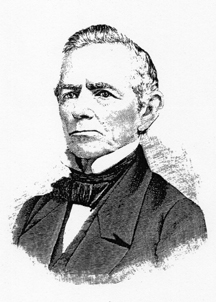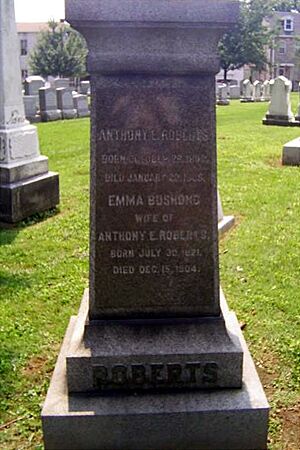Anthony Ellmaker Roberts facts for kids
Anthony Ellmaker Roberts (born October 29, 1803 – died January 23, 1885) was an American politician. He served in the United States House of Representatives from 1855 to 1859. Roberts was also an abolitionist, meaning he was against slavery. He was a close friend and partner of Thaddeus Stevens, another famous abolitionist.
Contents
Early Life and Work
Anthony Ellmaker Roberts was born in 1803 near Barneston Station in Chester County, Pennsylvania. His family moved to Lancaster County, Pennsylvania in 1804. Anthony went to a local school, but his education was limited.
When he was 13, in 1816, Roberts started working. He was a clerk in his uncle Isaac Ellmaker's store in New Holland, Pennsylvania. By the time he was 20, Anthony owned a part of the store. He continued working there until 1839.
Starting in Politics
On October 8, 1839, Roberts was elected as the Sheriff of Lancaster County. He was part of the Democratic Anti-Masonic Party. He then moved to Lancaster, Pennsylvania, and served as sheriff for three years, until 1842.
In 1843, Roberts tried to become a member of Congress. He ran for the Anti-Masonic Party but lost the election. Later, on May 16, 1850, President Zachary Taylor chose Roberts to be the United States Marshal for Eastern Pennsylvania. He held this important job until May 29, 1853.
The Christiana Resistance
A Difficult Law
Just a few months after Roberts became a Marshal, the U.S. Congress passed the Fugitive Slave Law. This law was part of the Compromise of 1850. It made Roberts' job very hard because he was an abolitionist. The law said that marshals had to help return runaway slaves to their owners in the Southern states. If they didn't, they could be fined a lot of money.
There were many tense situations in the North. Local communities often helped runaway slaves, while slave owners tried to get their "property" back. A serious event happened on September 11, 1851. Edward Gorsuch, a slave owner from Maryland, came to Christiana, Pennsylvania, in Lancaster County. He wanted to get back a runaway slave named Nelson Ford.
A group of runaway slaves in Christiana had formed a group to protect each other. This group was led by William Parker. Edward Gorsuch found out that his former slave was staying with William Parker. He went to Parker's house with a small group of people to take back the slave.
The runaway slaves, led by William Parker, sounded an alarm. This brought other African Americans and some local white abolitionists to help. When Edward Gorsuch tried to take his "property," William Parker led a strong resistance. A small fight broke out. About an hour later, the incident was over, and Gorsuch was dead.
Roberts' Role in the Trial
Two days later, Anthony Roberts arrived at the scene with police from Philadelphia. Everyone who took part in the resistance, including white people who were just watching, was arrested. They were put on trial for treason. The first person to be tried was Castner Hanway, a white man who supported the abolitionist cause. Thaddeus Stevens became the defense attorney for the accused. Marshal Roberts was in charge of keeping the people on trial in custody.
The lawyers trying the case had two Black men in custody. These men had found out about Edward Gorsuch's plan the day before the resistance. They had warned William Parker. The prosecution wanted to use their statements to prove that the Christiana incident was an organized plan to go against U.S. laws.
However, two weeks before the trial, the two Black men disappeared from custody. There was no sign of a broken lock or forced entry. The prosecution hinted that Marshal Roberts had let them go. The defense lawyers said this was not true.
Twenty-one years later, William Still, a Black leader of the Philadelphia Underground Railroad, told the truth. He said that while the two men were in custody, their owner identified them as runaway slaves. Still wrote that the two men did find a "true friend and ally" in Roberts. He added that the suspicions about Anthony Roberts were "founded on fact." This meant Roberts had indeed helped them escape.
Roberts also did other things to influence the case. As the Marshal, he was responsible for choosing potential jurors. Robert J. Brent, Maryland's Attorney General, was part of the prosecution team. He later said that "a large majority" of the potential jurors Roberts chose were "unfavorable to a conviction." This meant they were likely to find the accused not guilty.
On November 27, 1851, Roberts allowed a Thanksgiving meal to be prepared for all the prisoners. He even ate with them in the prison. Maryland's Attorney General criticized Roberts for not being "impartial" or showing proper "decorum."
Scott's Changing Story
Later in the trial, Roberts was involved in another event that affected the case's outcome. A Black man named George Washington Scott was supposed to say that he was at the Christiana fight. He was going to say he saw the men who shot Gorsuch. He would also say the group was organized to "resist all slave holders."
But when Scott was called to testify in court, he changed his story. He claimed he was not there that day. This surprised the prosecuting attorneys. It turned out that the night before, Roberts had allowed several Black men into the prison to "talk" with Scott.
Maryland's Attorney General was very upset. He indirectly accused Marshal Roberts of influencing a witness. He pointed out that all the other Black men in custody looked neat, but Scott was "ragged, dirty, and filthy." Despite the prosecution's protests, Scott insisted he was not at the battle. He said he had lied earlier because he was scared. In the end, Castner Hanway was found not guilty. Since his case was a test, the prosecution decided not to try the remaining cases.
Later Political Career
In the 1854 congressional election, Thaddeus Stevens supported Roberts. Roberts ran as a Know-Nothing candidate for Congress in Pennsylvania's ninth district. Some people were very surprised by Roberts' candidacy. One newspaper said he was "consistent only in his blind obedience to Thaddeus Stevens."
Despite this, on October 13, 1854, Roberts won the election. He defeated his opponent, Isaac Ellmaker Hiester. Roberts became the first Republican to represent Lancaster County in Congress.
The Republican Party was just starting to form that same year. Its main goal was to stop the spread of slavery. In 1855 and 1856, Roberts was a leader in setting up the Republican Party in Pennsylvania. He strongly supported its ideas. When his first term in Congress ended, he ran for re-election as a Republican and won a second term. During his second term, he served on the Public Buildings and Grounds Committee. He served in Congress from March 4, 1855, to March 3, 1859.
He did not run for re-election in 1858. Roberts continued to be active in politics. He helped organize the Republican Party in Pennsylvania. In 1867, he ran for Mayor of Lancaster but lost. His obituary, published in 1885, said that his actions in Congress "were always true to his constituents."
Other Community Activities
Roberts was very active in public life and was part of many committees. In 1830, he helped distribute protests against a plan to create a new county from parts of Lancaster, Chester, and Berks counties.
On April 5, 1841, Roberts was chosen as a secretary for a meeting. Citizens of Lancaster met to express their sadness over the death of President William Henry Harrison. On June 13, 1848, Roberts was appointed to a committee. This committee collected money to help people who lost things in a big fire in Allentown, Pennsylvania. After President James Buchanan died in 1868, Roberts helped arrange his funeral services. Roberts also served as chairman of the School Board's visiting committee in Lancaster.
Roberts owned a lot of land in and near New Holland, Pennsylvania. He seemed to use his land to help education and the public good. In 1845, he bought a building known as the Methodist Meeting House. Six years later, he sold it to the Earl School District.
In 1850, he finished building what was then the largest house in eastern Lancaster County. The purpose of the building was a mystery until it was finished. Roberts then announced that a special school would open in part of his home. He also helped free many properties from rent systems that were unfair to the common people in New Holland. In 1860, in Lancaster City, he helped start an organization. This group provided homes for poor and uncared-for children. One writer noted that the common people of New Holland "looked upon him as their friend and champion of their rights." As a close friend of Thaddeus Stevens, Roberts was named one of the people in charge of Stevens' will after he died.
Family and Later Life
In 1840, Anthony Roberts married Emma Bushong. She was about 18 years younger than him. They had 12 children together. Anthony died in Lancaster City on January 23, 1885, when he was 81 years old. He was buried in Lancaster Cemetery. One writer described his life as being "characterized by firmly-established principles of justice and right to his fellowmen." He was known for his independent thinking and for always trying to do his duty as a citizen.




